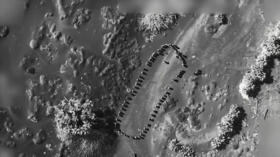NASA reveals images of ‘Spooky’ asteroid that zipped past Earth on Halloween

Ready for a “Spooky” close-up? NASA is showing off high-res images of the 400-meter-wide (1,300 feet) asteroid that zipped past Earth on Halloween, revealing its eerie skull-like face.
Nicknamed “Spooky” for its skull-resembling shape, the asteroid – otherwise known by its NASA classification as 2015 TB145 – was flying 480,000 kilometers from Earth when it passed on October 31. It was impossible to see that far away, but now NASA pictures allow us to take a closer peek.
The agency used huge, Earth-based radio telescopes and antennas to capture the images. By bouncing radar signals off the asteroid, NASA created a detailed picture of Spooky’s surface.
"The radar images of asteroid 2015 TB145 show portions of the surface not seen previously and reveal pronounced concavities, bright spots that might be boulders, and other complex features that could be ridges," said Lance Benner, who leads NASA's asteroid radar research program at its jet propulsion laboratory in Pasadena, California.
See radar bounced from CA to W.Va off the #HalloweenAsteroid while it was going 22 miles/sec https://t.co/8CkqO4A2bxhttps://t.co/2cmzZ6B8AP
— NASA JPL (@NASAJPL) November 3, 2015Taking such pictures is quite a complicated process. NASA used a 230-foot antenna called DSS-14 at Goldstone, California, to send high-power microwaves at TB145. The signals then bounced off the space rock and headed back toward Earth, where they were received by the 100-meter Green Bank Telescope at the National Radio Astronomy Observatory in West Virginia.
New animation by #TeamRadar of #2015TB145 using @NAICobservatory on November 1: pic.twitter.com/Isz0Gafuop
— Arecibo Radar (@AreciboRadar) November 2, 2015The new images gave NASA a new “perspective” on 2015 TB145. Benner said that the latest pictures “look distinctly different” from those they obtained from the Arecibo radar a day before.
The research community watching the asteroid has been curious about its unusual orbit, as it looks more like the orbit of a comet rather than that of an asteroid.
"The images look distinctly different from the Arecibo radar images obtained on Oct. 30 and are probably the result of seeing the asteroid from a different perspective in its three-hour rotation period," Benner said in a statement.
The asteroid has an estimated diameter of 689 to 2,133 feet (210 to 650 meters), some 32 times the size of the asteroid that hit Russian city of Chelyabinsk, Siberia, on February 15, 2013.
Spooky is traveling at 78,000 miles (125,000 kilometers) per hour, or 35 times faster than a high-velocity rifle bullet.
The asteroid was first spotted on October 10, 2015 by the Panoramic Survey Telescope & Rapid Response System (Pan-STARRS), located on Hawaii’s Mount Haleakala.
The next time 2015 TB145 will be passing by Earth's neighborhood is in September 2018.














